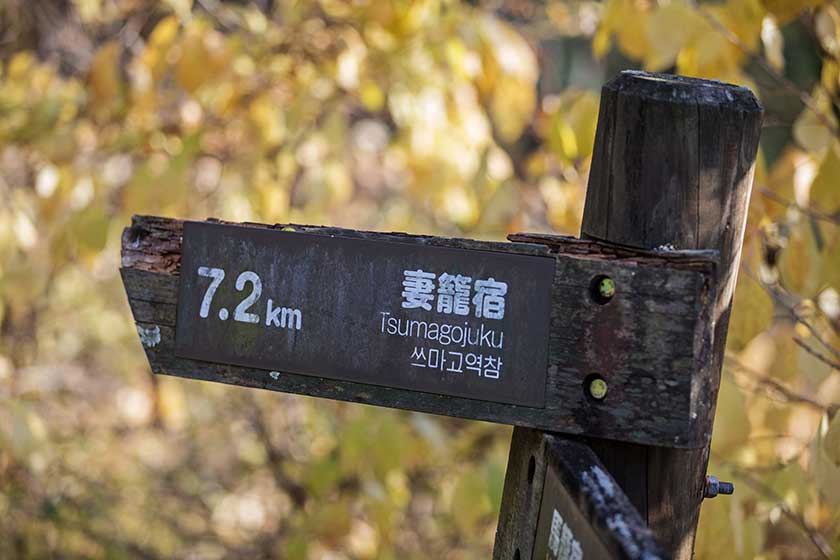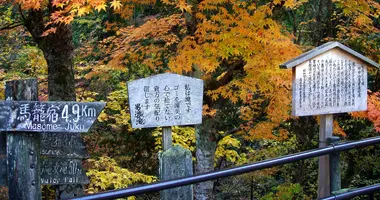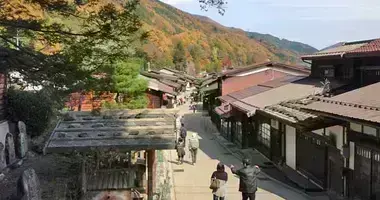Tsumago: Stepping back in time in a beautifully preserved Edo period post town
- Published on : 25/03/2024
- by : Japan Experience
- Youtube

Nestled in the heart of Japan's Kiso Valley lies Tsumago, one of the best preserved post towns from the Edo-period. Located on the historic Nakasendo route between Kyoto and Edo (Tokyo), this charming town has made great efforts to recreate the authentic ambience of the Edo era, allowing visitors to imagine they have slipped back to an earlier time in Japan's history. A visit to Tsumago is a journey into the past, offering a glimpse of life as it was centuries ago.
The history of Tsumago as a post town on the Nakasendo route
During the Edo period (1603-1868), Tsumago thrived as the 42nd of the 69 post towns along the Nakasendo, a major route connecting Edo (modern-day Tokyo) and Kyoto. As a post town, Tsumago provided lodging, food, and other services to the countless travelers who passed through, including samurai, merchants, and pilgrims. The town's prosperity was closely tied to its strategic location on this bustling highway.
However, with the advent of the railway in the late 19th century, the Nakasendo fell into decline, and Tsumago's fortunes faded. By the 1960s, many of the town's historic buildings had fallen into disrepair, and the community faced the threat of rural decay. It was then that the locals made a bold decision to preserve their heritage and restore Tsumago to its former glory as an Edo-period post town.
Preserving the Edo period atmosphere in modern times
The preservation efforts in Tsumago began in the late 1960s, with residents coming together to restore the town's historic buildings and streets. By 1971, some 20 houses had been restored, and the community agreed to a charter stating that no place in Tsumago should be "sold, hired out, or destroyed". This commitment to preservation has helped maintain the town's authentic Edo-period atmosphere.
Today, Tsumago's main street is closed to vehicular traffic, and great care has been taken to hide modern elements such as power lines and telephone poles. Visitors can stroll along the picturesque street lined with traditional wooden buildings housing inns, restaurants, and craft shops. The absence of modern intrusions helps create an immersive experience, transporting visitors back in time.

Key historical buildings to visit in Tsumago
Tsumago boasts several well-preserved historical buildings that offer insights into life during the Edo period. The Honjin, the town's former main inn for high-ranking officials, has been reconstructed to its 1830s appearance, while the Wakihonjin, which accommodated second-tier officials, still retains its original 19th-century structure. Both buildings now serve as museums, showcasing artifacts and exhibits related to the town's history.
Another notable site is the Kotoku-ji Temple, founded in 1500. The temple features a unique "tatami" floor that squeaks when walked upon, designed to alert the occupants to potential intruders. Visitors can also explore the ruins of Tsumago Castle, which offer panoramic views of the town and surrounding mountains.
Hiking the scenic Nakasendo trail from Tsumago to Magome
One of the most popular activities for visitors to Tsumago is hiking the Kiso Valley Nakasendo Hike to the neighboring post town of Magome. The well-maintained 8-kilometer trail winds through lush forests, past waterfalls and traditional farmhouses, offering a chance to experience the natural beauty of the Kiso Valley. The hike takes approximately 2-3 hours and is suitable for most fitness levels.
Along the way, hikers can stop at the Otaki and Medaki waterfalls, which are said to have been used by men and women, respectively, for purification rituals in the past. The trail also passes by a traditional tea house where visitors can rest and enjoy complimentary tea and sweets. For those who prefer not to walk back, a bus service is available between Tsumago and Magome.

Wooden Post Office building in Tsumago
Discovering the ancient Otake and Medaki waterfalls near Tsumago
Located just a short distance from Tsumago, the Otake and Medaki waterfalls are steeped in history and legend. These twin waterfalls, also known as the Male and Female falls, are mentioned in the classic novel "Miyamoto Musashi" by Eiji Yoshikawa. In the story, the famous swordsman Musashi and his lover Otsu stand under the respective falls to cool their ardor.
Visitors can easily access the waterfalls from the Nakasendo trail between Tsumago and Magome. The short detour to the falls offers a chance to appreciate the natural beauty of the area and learn about the fascinating legends associated with these ancient sites. The serene atmosphere and soothing sound of cascading water make the Otake and Medaki waterfalls a must-visit destination for those exploring the Kiso Valley.
Tips for getting to Tsumago and making the most of your visit
To reach Tsumago, visitors can take a train to Nagiso Station, the nearest railway station, and then take a short bus or taxi ride to the town. For those driving, Tsumago is accessible via Route 19, approximately 1 hour and 15 minutes from Nagoya when traffic is normal.
When planning your visit, consider staying overnight in one of Tsumago's traditional ryokan or minshuku to fully immerse yourself in the Edo-period atmosphere. Many of these inns offer authentic Japanese cuisine and a chance to experience a slice of local life. Be sure to check the Magome Tourist Office for information on accommodation options and local events.
To make the most of your time in Tsumago, explore the town on foot, taking in the historic architecture and visiting the various museums and temples. Engage with the friendly locals, sample traditional crafts and cuisine, and soak up the unique atmosphere of this beautifully preserved post town. By stepping back in time in Tsumago, you'll gain a deeper appreciation for Japan's rich history and cultural heritage.

















